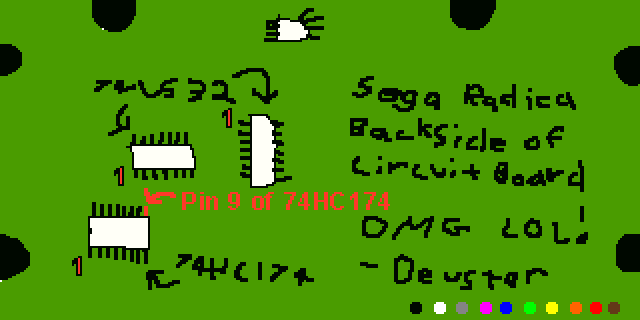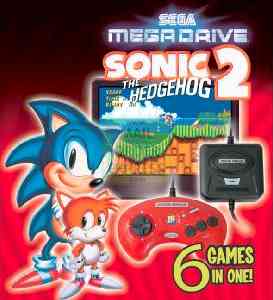Index
|
|||
|
>> What is this "Sega Radica", and how can it be of use to us engineers? The Radica is a six-in-one Sega Genesis game playing machine. The manufacturing of Sega Genesis systems, and cartrdige games has been long discontinued by Sega, and has now come back to life with the Radica, bringing a couple of classics from the Genny's legacy, and placing them all in one miniature micro-console. Playing games and all is only good for kids, and grown ups who still like the good-ol days, but what use does a Radica have for tinkerers? One of the finest uses of a Radica is to use it to play games that are on a cartridge, or on an external memory, instead of limiting game play to the games provided by stock. Because a Radica can be modified to play some cartridge games, an individual can build a miniature Sega Genesis system. The Radica is also good for developing Sega Genesis games, since it is possible to develop games/programs that will run on it. Currently, there are three editions of the Radica: Radica v1, Radica v2, and the Street Fighter Edition. I only own the first edition, so there's not much information I can get for the other two, however, they should be the same architecture. The first edition of the Radica came out with these size games:
The second edition came with these games:
Here are the Sega Genesis basic specifications (what the Radica tries to duplicate all in one chip-on-board package!):
I should post more info + pictures on how to perform this later Page Updates:
| |||
|
>> Game Compatability Facts about the Radica:
Games that don't work at all:
| |||
|
>> Power Up! The Radica takes 4AA batteries, and the cut-off voltage is around 4 volts. When the voltage falls lower than the cut-off, the regulator will fail to provide a 3.3 volt voltage source to the chips The regulator in the Radica is a very good 3.3 volt LDO linear regulator. I wouldn't try to switch in another regulator at all - unless a switching power supply can be connected to this power sink. Just a reminder: The old Sega Genesis ran on 5 volts. This means that its peripherals and memory are 5 volts tolerant. So this means that connecting 3.3 volts to a cartridge, or even a joypad isn't suppose to work! If you want to have greater compatability with your Radica fitted with a cartridge, then you need to provide 5 volts to these peripherals, unless you're chicken :). | |||
|
>> Layout of the mask ROM (aka the memory map) For the first edition Radica: 0x000000-0x0FFFFF - Kid Chameleon 0x100000-0x1FFFFF - Dr Robotnik 0x200000-0x27FFFF - Sonic 0x280000-0x2FFFFF - Golden Axe 0x300000-0x37FFFF - Altered Beast 0x380000-0x39FFFF - Flicky 0x3F0000-0x3FFFFF - Redica Menu  The Radica Menu program running on a Sega Genesis emulator! | |||
|
>> Mask ROM pinout When looking at the Radica pcb, pin 1 of the mask rom is the pin closest to the joypad connection
D0-D7 are odd addresses in the 68k D8-D15 are even addresses in the 68k | |||
|
>> Banking schemes (how different games are selected) The banking circuit is just a plain old OR gate that is controlled by a latch. When an OR gate is brought down logic 0, then the address lines from the CPU are buffered to the ROM. When the OR gate is energized to logic 1, then a logic 1 is presented to the ROM, independent of the CPU's corresponding address signal. There are 6 OR gates, which controls the entire 4 Mb array. Therefore, 64 segments can be banked, and 64 Kb pages are made. The OR gate control latch is controlled by performing a read or write to addresses 0xA13000 - 0xA1307F, where every other address selects a different bank (see the bakning schematic) Banking Schematic | |||
|
>> Joypad operation The chip (with the chip-on-board package) inside the Radica controller is the same as a 74HC157 data selector First, here are the signals going to the controller:
| |||
|
>> Good Downloads! The entire Radica V1 Mask ROM - dumped by Devster himself (that's me)! Radica V1 menu program - the menu program extracted form the rom dump, made by me also Radica Banking Schematic - if you didn't get a chance to read the banking section Attach a manual bankswitching switcher - if you wanna play the Mask Rom on your real Sega Genesis hardware.txt - Contains pinouts to the cartridge slot. Thought I'd put this up here because it might be useful I have the second version of the Radica, but have not yet hooked up it's game rom onto a cartridge! I'll try to do that soon. | |||
|
>> More Games Mod (aka Devster's SNK Mod) To play more games, like Sonic 3, Sonic and Knuckles, and Street Fighter (the 40mbit version), you will need to perform a modification to the Radica's banking hardware. Without doing this mod, a stock Radica modded with an external cartridge port will not be able to play these three games in your collection (or even more games maybe). Bob says: So what causes my Radica to crash when playing these games?? :(??? Well Bob, the answer is simple -- when games such as Sonic 3 and SNK (Sonic + Knuckles) start up, these games will write a value into register $A130F1. Sonic 3 will write to this register to enable and disable writing to its save game memory. Games such as Super Street Fighter, or some other Hong Kong bootleg will write into this location to switch memory banks. The Radica uses the register array from $A13000 to $A130FF to switch in different games into $000000 - no wonder the Radica crashes when playing sonic 3 (the Radica will bankswitch the memory -- bad bad)! Why don't we just rip off all the bankswitching chips???? To be compatible with Street Fighter, we can't just ignore this register, we'll need to put it to good use. We will need to connect an extra signal to the cartridge called /TIME. On the Radica board, this signal is located on pin 9 of the chip marked 74HC174 (or HC174 for short) on the bottem of the Radica board. This chip is a 16 pin Hex-D Flip Flop with a clear (refer to the Banking Scheme for the function of this IC in the Radica). You will need to lift pin 9 up, and then solder a wire going to VCC or 3.3 volts, pulling it high so that we don't have the pin floating. You will then need to connect a wire from the pad of pin 9 to your cartridge slot on pin B31. If you've already hooked up your cartridge slot, then B31 is located directly across from the +5v supply (the +5v supply closest to the data pins, eg: D11). That's all you need to do - hook up two wires. The first one to the '174 might be optional, but we connect it anyways to ensure that the flip-flop doesn't get written. Public service announcement: The 74HC174 has 16 pins on it. The other chips are 74LS32 or-gates, which contain 14 pins. These chips can be removed, but I think it's worthless since the electrical current saved is very negligible (around the uA). If you are going to remove these chips, refer to the banking scheme in order to get the higher address lines A21-A16 working again. In short, to perform this mod, do these steps:
 An artist's rendering of pin 9 I have no pictures of this mod, but I'm hoping that there'll be plenty of pictures of this two wire mod once people start doing it :)! Writing to Sonic 3's FRAM will not work on this mod. A write enable signal from the Radica must be generated in order to write to any cartridge memory. This mod, and obtaining the parts for it goes beyond the scope of many hobbyists. | |||
|
>> Where to go to get extra help DevSter Specialties: http://devster.monkeeh.com DevSter's Forum: http://devster.proboards22.com | |||
